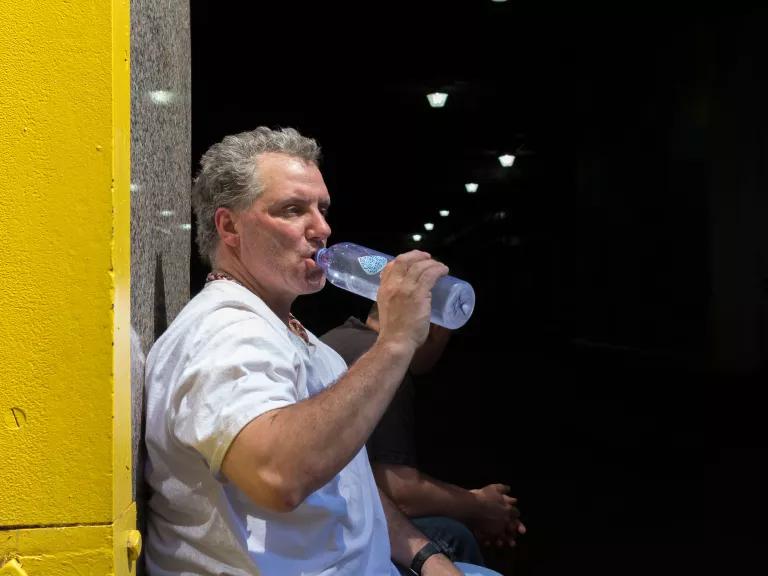Yes, Workers Need OSHA’s Protection From Deadly Heat
OSHA's proposed heat standard is an essential step toward a safer, healthier future for U.S. workers.

USDA/Lance Cheung, Public Domain
This summer’s extreme heat has not been kind to workers. Wednesday “Wendy” Johnson, a 51-year-old employee of the U.S. Postal Service, died after she was found unconscious on a June day in North Carolina. She had spent hours working in the type of truck her coworkers call “easy bake ovens,” due to their lack of air conditioning. An unnamed construction worker in Rhode Island died after apparently working for four hours straight without a break during a June heatwave. And Edgar Ordonez, a 33-year old New York City Police recruit, died after a few hours of high-intensity training outdoors in the July heat.
While we’re still waiting for confirmation that heat caused the deaths of these workers, the combination of high heat exposure, strenuous work, and not enough breaks is exactly the problem the federal Occupational Safety and Health Administration (OSHA) is trying to solve with its first-ever proposal for a heat safety standard. Federal data suggests that in an average year, about 40 workers die and nearly 3,400 others miss at least one day of work from heat-related causes. And these numbers “are likely vast underestimates” according to OSHA.
The proposal released on July 2 would require employers to provide basic human rights on hot days: water, cool places to rest, and education on how to keep people safe. The draft standard itself is just 19 pages long, but is backed up by more than 1,100 pages of evidence and analysis. Once the proposal is published in the Federal Register, the public will have the opportunity to tell OSHA everything they got right and what they need to do better.

Don Harder, Creative Commons / CC BY-NC 2.0
Here are some of the most common questions I’ve heard about the proposed heat standard.
It’s hot everywhere. Why do workers need a special heat standard—and why now?
If you’re mowing your own lawn or cleaning out your attic on a hot summer day, no one can keep you from taking a break, getting a glass of water, or even deferring your task to cooler day. In the current economy, however, too many workers are denied these basic safeguards on the job.
OSHA found in a review of more than 200 cases of heat-related workplace deaths that employers frequently failed to provide protections such as water, shade, timely medical care, and time for new workers to get used to the heat. Some employers actively prevented overheated workers from taking rest breaks. Others left sick workers alone and unsupervised to perish from preventable causes.
Lots of employers do the right thing, of course. But as OSHA puts it: "The existence of adequate protections in some workplaces speaks to the feasibility of the standard, not necessarily to the lack of need."
As to the question of “why now,” the answer is partly climate change. Heat is an old, old problem for workers, and experts in the Nixon administration recommended federal heat standards more than 50 years ago. Workers have been waiting ever since. In the meantime, every season has gotten warmer and heat waves have gotten longer and more intense.
Who will and won’t be covered by the heat standard?
OSHA estimates that the current proposal would protect about 36 million outdoor and indoor workers. This includes employees at hot workplaces as varied as construction sites, factories, restaurants, warehouses, car repair garages, and even elder care facilities.
The heat standard would fully apply to most private sector industries and the U.S. Postal Service. Although most other federal agencies would likewise have to comply, OSHA has limited enforcement powers in agencies outside of the Postal Service.
Many state and local government workers, however, will be left out—including in most of the hot states in the Heartland and the Southeast—even if they’re engaged in waste management, landscaping, or other strenuous outdoor jobs. That’s because federal worker health and safety standards don’t apply to state and local governments unless they are in states with OSHA-approved plans.
The current draft also exempts a few classes of workers who are regularly exposed to heat, such as firefighting organizations. And because of decades of marginalization by previous pro-business administrations and members of Congress, plenty of other highly heat-vulnerable workers such as incarcerated workers, workers on small farms, and domestic workers will fall through the cracks.

Elvert Barnes, Creative Commons / CC BY-SA 2.0
Aren’t there other ways to keep workers safe? Why should businesses deal with yet another rule?
OSHA considered—and rejected—three alternatives to a formal heat standard.
- Voluntary or mandatory information dissemination programs. While it’s true that workers and supervisors need information on how to evaluate and respond to heat hazards, more education is not a complete solution. That’s because employers can have a strong economic incentive to keep information about hazards to themselves, and workers are often not empowered to act on the information they have. I’ve regularly heard workers say they know they need more breaks, water, and first aid training—but that they’re afraid of retaliation by their employers.
- Workers’ compensation claims. Research has found increases in workers’ compensation claims when the temperature soars. Could the increased costs be enough to compel employers to protect workers? Probably not on their own, because state laws put caps on how much employers pay out for work-related health claims—meaning workers pick up the rest of the tab. Furthermore, workers’ compensation is structured to spread risk across industries and “prevent individual employers from suffering a catastrophic loss” and premiums are largely based on past conditions, not future possibilities.
- Tort liability options. Instead of a regulation, workers could use the courts to seek compensation for heat-related harms to their health and finances. As OSHA writes in its Preliminary Economic Analysis for the draft standard, however, "With limited exceptions, the tort system has not been a viable alternative to occupational safety and health regulation." For one thing, it’s an expensive and lengthy process. It’s also not even possible under some state laws, which have made workers’ compensation the “exclusive remedy” for getting sick or hurt at work.
How long will it take to see a final heat standard?
OSHA has a lot of legal hoops to jump through during rulemaking, meaning we may be waiting at least another two to three years for a final standard. In the interim, it will be important for workers to keep the pressure on OSHA and the White House, and to keep using their collective muscle to win heat protections through contract negotiations, purchase agreements, and other methods.
Given the potential wait, states like Maryland and Nevada should also finalize their own heat standards as soon as possible.
Finally, companies should use the OSHA’s current commonsense proposal as a roadmap for doing the right thing.
The problem of killer heat isn't going away; it's only getting worse. It’s outrageous to allow workers to die from preventable heat-related causes when plenty of feasible, commonsense protections are right in front of us. So, until OSHA’s proposal is finalized, states and companies must follow its lead to protect their workers at long last.



